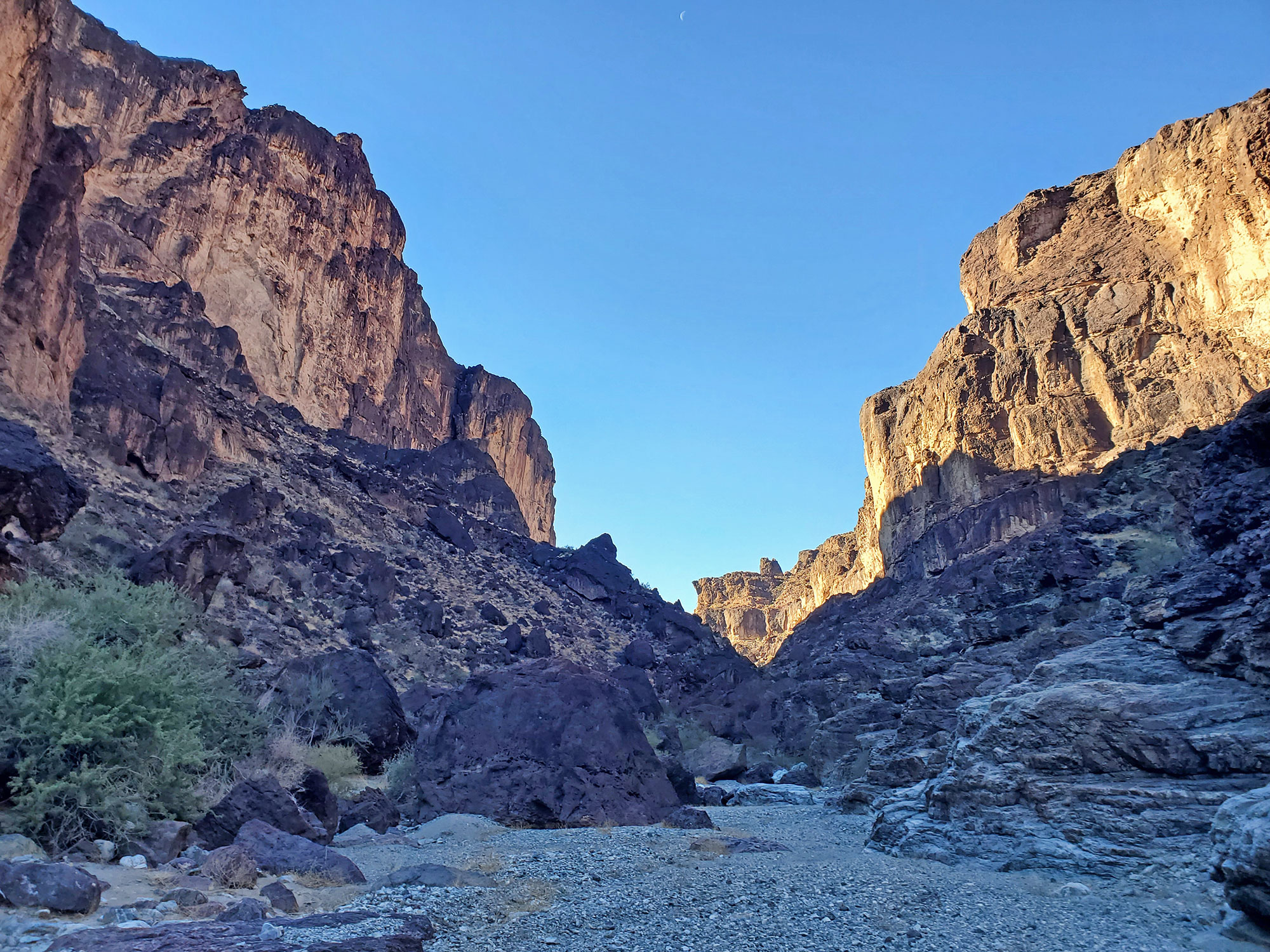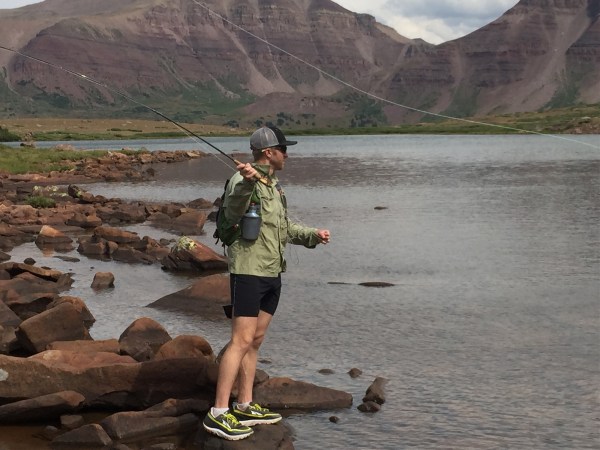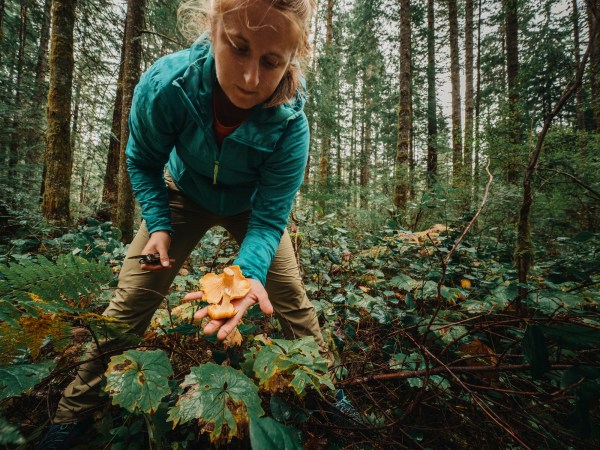I slung my pack over my shoulder and hoisted it up, feeling the weight of six days worth of food in the balls of my feet. It was late afternoon and I already knew I had skimped on water. The penchant to under carry water in sections where you needed to over carry food was all too real, and dangerous. She (my pack) was heavy, but not heavy enough.
By this stage in my thru-hiking life, I usually assessed my water carries by weight, feeling, and gut instinct. But sheer luck alone wouldn’t get me across the desert, so I counted my bottles, in liters, and did some quick math in my head. Sure enough, it wasn’t enough. Not even half of what I needed to be comfortable and well hydrated. But past experience had informed my physical tolerance for dehydration and my mental tolerance for risk. I felt confident that I could push myself in this section of our hike without irreparably harming my health, or my emotional fortitude.
My hiking partner, “Camelback,” had joined me for this low-desert route, a 1,500-mile trek in total across the Sonoran, Colorado, and Mojave Deserts of western Arizona and southeastern California. We would be largely off trail as we hiked across 28 wilderness areas, 11 national parks and monuments, four national forests, two state parks, and large, intermittent swaths of BLM land. Our trail meandered south from the Utah-Arizona state line, and took a hard right at a mountain pass outside of Tucson. It then headed roughly 800 miles west until it ended at Joshua Tree National Park. But this section had us walking both established tread and traversing cross-country along unnamed washes, over scant, crumbly passes, and across wind-whipped valleys.
This had all started as a flippant pitch over the phone while I was standing in my mom’s driveway. It was a sunny and hot day, and I was in the trenches of frontcountry obligations. It was the quintessential cocktail of hairbrained scheming, especially with another thru-hiker. We had originally met on the Continental Divide Trail on our respective thru-hikes seven years earlier. Hiking a remote desert route at the height of winter wasn’t a hard sell.
Running Dry, Again
It can’t actually be called “deja vu,” which describes a sensation of having experienced something before, when you’ve quite literally experienced it in the real world. And recently. This wasn’t my first long distance desert hike where I’d run short on water. And still there I was, trudging forward, uphill on a two-track dirt road in the unrelenting winter sun and unseasonable warmth, a nagging knowing in my gut telling me this was a tad risky, even by my measure. It didn’t help that I was already swigging down water from all those salty town provisions I had eaten the day prior.
I had started this 50-mile section with 4 liters of water. Fifty miles of hardscrabble, cross-country walking with a roughly 40-pound pack. I expected it to take us three days to hike. Plenty of experienced long-distance hikers would have carried upwards of 10 liters.
It felt as though I were looking down at myself, like a bird disdainfully watching from above, making the same foolhardy decision I had the year before. I saw myself moving slowly but determinedly toward the silhouettes of the Whipple Mountains that filled the skyline in front of me, knowing that even though civilization and potable water were close, once you cross that emotional threshold back to trail, they may as well be a world away.
I had re-entered the dimension where singularity was king, the one dogged vision, the Absolute and Non-Negotiable Option. I was back to The Walk and, for better or worse, I would walk until I found water in the wild — or didn’t.
We walked into the night, like we had every day of this nascent traverse. The winter solstice, the shortest day of the year, was fast approaching. The sun set, the moon rose, constellations popped into view and my pupils worked to soak up the residual light pulsing on the horizon. Orange turned to lavender to royal blue before I finally caved and got my headlamp out of my hipbelt.
Though developing my night vision is a point of pride, tonight — where there are remnants of tailings and yawning open pit mines — I push my ego aside to attend to more practical concerns, like not breaking my face a second time. In the last section, I had slipped and fallen on slickrock while back-climbing an impassable slot canyon, breaking off a decent chunk of my lateral incisor. I didn’t think I’d enjoy tumbling down an open pit mine, and being an American I was pretty sure the medical bill — assuming I survived — would be beyond my pay grade as a professional dirtbag.
Mysterious lights bobbed and dipped along the outline of mountains on the horizon, mirages after the last fading light of sunset had passed. My imagination ran ahead of me in the dark, becoming its own wild creature of the night. It wrestled with what these bright orbs of light could possibly be, my crunching feet and the click of my trekking poles keeping me company. I meandered upwards on the decommissioned mining road as it drew closer to these lights floating in the inky night. It had to be people who held a local mining claim finishing up some sunset prospecting, I finally told myself. Satisfied for now with this realization, I sought a flat patch of dirt and gravel alongside the mining track. The little turn-out at the side of the road was a welcome sight, and would be more than adequate for tonight.
With my focus temporarily distracted from water and the lack thereof, I set up my tent and slithered into my sleeping bag, listening to the wind’s soothing yowl and the flapping of my shelter. My lips were taut and cracking and my cheeks were already splotched with bright pink streaks from the sun, but I disregarded these problems for the time being, and pulled my sleeping bag over my head, inhaling that musty feather smell. Regardless of whatever else was happening, this place always felt like home. I slept like the dead.
I had 2 liters of water left for the next 35 miles.
I didn’t become a long-distance desert walker by having a high aversion to risk. Of course, for most people, walking cross-country through the desert is probably risky enough before contemplating a too-small water carry. That’s borderline dangerous. But when you’re enmeshed in a community of people who spend their lives walking for the sake of walking itself, there’s a self-assuredness that transcends reason. A knowing of oneself and your physical, mental, emotional, and even spiritual limitations, and what that means for each route that you hike. It becomes a combination of experience, and experimentation. It might look like we’re trying to be super human from the outside, but thru-hikers at this level know they are held together by cold-soaked ramen and Leukotape. In short, there was a lot of screwing around and finding out before I had gotten to the point of thinking this was the right plan for this route.
Donkey Water

“Don’t you think you should get water…?”
I blinked and looked down. We had hiked only six miles so far this morning and at my feet was a seep.
A seep is a hole dug in sandy, rocky terrain where the water table is relatively high. In arid, desert environs this is typically a canyon, wash, or arroyo. Water has the opportunity to percolate up through the porous ground and into the hole for consumption.
This particular seep was dug by wild burros, as evidenced by their trails side hilling the rocky mountainsides, traveling across buttes and mesas, and dropping low to cross washes — cleverly finding the path of least resistance as they pick their way through rocks, cacti, and unrelenting chaparral.
Burros were originally introduced to North America by Spanish colonizers in the 1500s. They were used in the 1800s primarily as pack animals for prospectors working in mines. At the end of the mining boom in the American West, many burros were turned loose and left to fend for themselves, forming herds and adapting to desert conditions in the wild. They were characterized as tenacious, determined, and capable. I loved their company, and they brayed my arrival to their compatriots from the canyon walls, their ears rotating to get a better read on me and my intentions.
My hiking partner looked toward me hesitantly. The crux of the narrowing wash was closing in just ahead of us. I blinked again and slowly registered the narrowly dug hole filled with several inches of silty water.
“A wet ass hole!” I cracked, my voice croaking out from parched vocal chords.
I was so dogged in my death-march toward the next sure water source that I nearly made a dire oversight. I looked ahead, up the canyon, and shook off the urge to trudge forward at all costs.
When I looked back at my hiking partner, I saw him patiently waiting for a more appropriate reaction to take hold.
“I have just the thing for this exact situation!” I exclaimed, slinging off my pack. I dug into a side pocket and procured the Capri Sun that I had slurped down at a doughnut shop in town, hundreds of miles ago. I had already sliced the top off before the hike commenced in anticipation of a potential moment such as this, and it made the perfect foil envelope for scooping water out of the seep.
I scooped a couple liters, careful to skim off the top of the small pool and not rough up any of the sediment settled into the bottom of the hole, or risk collapsing the sides of the seep in on itself. I gingerly passed the golden chalice to my partner. He then proceeded to collect a couple of liters, doing so as painstakingly as I. It was after all, a miracle recognized by both of us, and almost felt like a sacred act. We snapped a quick photo in front of the Lucky Seep, unable to contain our grins — or our relief.
I walked on, observing the bits and bobs of scattered bones and remains beckoning us further up the canyon. The creatures that came before us had not fared as well.

Cresting the Whipple Mountains
Our next vetted water source was 30 miles away, in the form of a rain catchment system maintained by the Arizona Department of Fish and Wildlife (in partnership with nonprofit organizations and volunteers) known as a wildlife guzzler. Wildlife guzzlers are a network of systems designed to collect rainwater for animals to drink in arid environments, such as the one we were traipsing through. They vary in design, and can be intended for upland game birds like quail or mammals like deer and elk. There are even guzzlers for bighorn sheep. Information on the location of these guzzlers is carefully safeguarded, and it’s important to be a good steward and always leave them better than you found it.
But before meeting the guzzler, there was a spine of mountains 25 miles long that we would need to traverse along the crest. This would be slow, tedious work involving climbing cross country and on burro trails from Whipple Wash, the main drainage corridor of the range, to the crest of the Whipple Mountains. We would then hike along the crest, gaining, losing, and regaining elevation, until we reached the 4,131-foot summit of Whipple Peak, the highest point in the range. The rest of the crest was more up-and-down, (as mountains tend to be) before gradually descending to another wash and hopefully — at long last — a camping opportunity. Given the time it took us to scoop water from the burro seep into our bottles, most of our climb, and descent, was going to take place under the cover of darkness.
I swung the beam of my headlamp around looking for the descending line of the crest in the dark. My hiking partner was a half mile ahead of me — his headlamp bobbed and floated down and away, a firefly in the sea of blackness opening up around me in all directions. The wind was kicking up and the residual warmth of the day quickly slipped away. I walked too quickly to a cliff’s edge and halted abruptly — a sense of impending vertigo had overcome me, as if the earth itself was about to fall away into the darkness. I picked the only other option, and was right this time, easing my way slowly downward, finding slight comfort in the fading headlamp light below me. “Focus,” I said to myself. “No mountain can go down forever.”
The People by the River
The Mojave Desert covers 20 million acres of the rainshadow of the southern Sierra Nevadas.
Broad, shallow seas covered the landscape in the Paleozoic Era, which eventually evaporated and left behind rich mineral deposits. The desert is a subsection of the Basin and Range Physiographic Province, characterized by isolated mountain ranges alternating with open, arid valleys in between. Sediment washes from mountain drainages and collects on the valley floor at the mouths of canyons in a unique topography called alluvial fans. Once enough sediment gathers in the form of alluvial fans, it creates a bajada, or slope, that can extend for miles.
The Mojave Desert is the namesake of the indigenous Mojave people, for whom the desert is the ancestral homeland. “Mojave” is their colonial name; the tribe calls themselves Pipa Aha Macav, translating in English to The People by the River — the Colorado River, the lifeblood of the region. The tribe believes the river itself was created by their spirit mentor Mutavilya, who instructed them in the art of cultivating the land.

The desert holds its secrets, its wounds, and bears them to you without fanfare or apology. It can’t hide them because there is nothing for them to hide behind. In the low desert there is rarely a plant over chest high — the wind blows the sand and grit away before things can be buried. There is no topsoil, nothing is covered, shrouded by trees, logs, moss, and mildew, or whisked away by flowing water. The desert cradles you and shows you it’s raw, unadulterated self, holding the mirror up to your own.
To the Guzzler
The next day started warm and bright. I squinted against the white hot light and walked briskly along an undulating two track to the bird guzzler, 49 miles from where we began two days earlier. I knew if there wasn’t water there, I’d need to hitch a ride to the nearest gas station with one of the long haul trucks passing through.
I put the thought out of my mind and doubled down, lengthening my stride in an attempt to make better time. The gravel crunched noisily; the two-track bobbed and weaved like a roller coaster. I was in a video game. My next objective was to find the Blue Gem. Aqua Dulce. Sweet Water.
Read Next: How Long Can You Survive Without Water?
No Bad Water
The wildlife guzzler was guarded by a large hairy tarantula under the cover of a spiky Palo Verde, but it was there. And that was the part that mattered. I had taken to repeating the phrase: “There’s no bad water, only a bad attitude.”
It started as me making fun of the absurdity of being particular about a water source when all that mattered was that water was present and could be collected, and drunk.
With each passing mile of desert hiking, I was saying it to myself more frequently and more earnestly.
I heaved the cover off the manhole like I was squatting a kettlebell and exclaimed happily. Water was present, and could be collected, and drunk.
I got down onto the ground and dug my elbows into the surrounding grit. I stretched my arm into the hole as far as it would go, and plunged my warped Smartwater bottle into the cool, amazingly clear water of the catchment tank. The first liter of water was going straight down my gullet in a nearby sliver of shade. The next however many were going on my back.
As I sat in the sand in my running shorts and sunshirt, I tilted my hat up and leaned back on my pack. I felt the life force return to my cells following three days of sustained dehydration. I also felt the now familiar feeling of being fully alive, in my connection to all that surrounded me, and that would continue to surround me through my journeys across wildlands.
I relished the joy of sitting with myself, with my backpack, and with my hiking partner — of decidedly not moving after moving so much in such a short amount of time. We rested, and our friend the tarantula dragged his legs through the sand to parts unknown. Shadows lengthened, the earth turned, the sun tracked toward the horizon. All was right in the world, and there was no such thing as bad water.
















